Hasselblad X1D vs Pentax 645Z
The Hasselblad X1D-50c and the Pentax 645Z are two professional cameras that were officially introduced, respectively, in June 2016 and April 2014. The X1D is a mirrorless interchangeable lens camera, while the 645Z is a DSLR. Both cameras are equipped with a medium format sensor. The Hasselblad has a resolution of 51.3 megapixels, whereas the Pentax provides 51.1 MP.
Below is an overview of the main specs of the two cameras as a starting point for the comparison.

Check X1D offers at
ebay.com

Check 645Z offers at
ebay.com
Going beyond this snapshot of core features and characteristics, what are the differences between the Hasselblad X1D-50c and the Pentax 645Z? Which one should you buy? Read on to find out how these two cameras compare with respect to their body size, their imaging sensors, their shooting features, their input-output connections, and their reception by expert reviewers.
Body comparison
The side-by-side display below illustrates the physical size and weight of the Hasselblad X1D and the Pentax 645Z. The two cameras are presented according to their relative size. Three consecutive perspectives from the front, the top, and the back are available. All width, height and depth measures are rounded to the nearest millimeter.
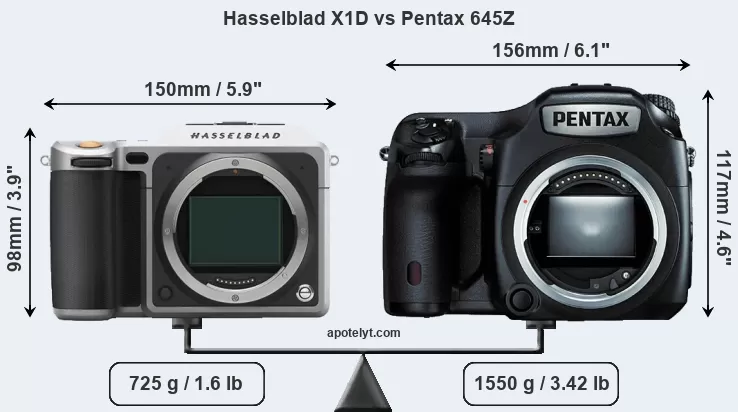
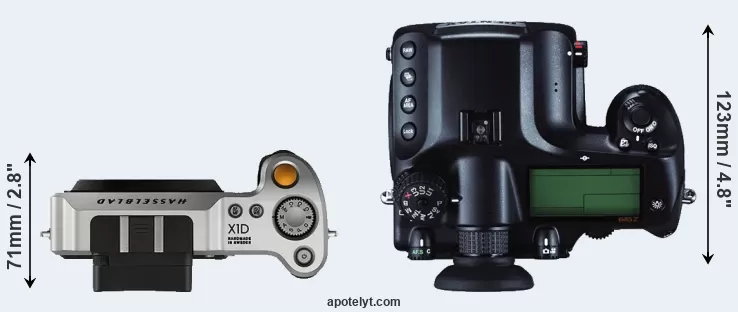
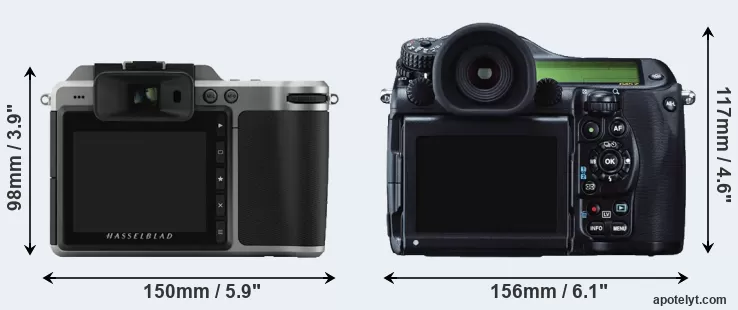
If the front view area (width x height) of the cameras is taken as an aggregate measure of their size, the Pentax 645Z is notably larger (24 percent) than the Hasselblad X1D. Moreover, the 645Z is substantially heavier (114 percent) than the X1D. In this context, it is worth noting that both cameras are splash and dust-proof and can, hence, be used in inclement weather conditions or harsh environments.
The above size and weight comparisons are to some extent incomplete since they do not consider the interchangeable lenses that both of these cameras require. Hence, you might want to study and compare the specifications of available lenses in order to get the full picture of the size and weight of the two camera systems.
Concerning battery life, the X1D gets .. shots out of its Hasselblad H-3054752 battery, while the 645Z can take 650 images on a single charge of its Pentax D-LI90 power pack.
The adjacent table lists the principal physical characteristics of the two cameras alongside a wider set of alternatives. In case you want to display and compare another camera duo, you can use the CAM-parator app to select your camera combination among a large number of options.

| Camera Model |
Camera Width |
Camera Height |
Camera Depth |
Camera Weight |
Battery Life |
Weather Sealing |
Camera Launch |
Launch Price |
Street Price |
||
|---|---|---|---|---|---|---|---|---|---|---|---|
| 1. | Hasselblad X1D | 150 mm | 98 mm | 71 mm | 725 g | .. | Y | Jun 2016 | US$ 8 995 | ebay.com | |
| 2. | Pentax 645Z | 156 mm | 117 mm | 123 mm | 1550 g | 650 | Y | Apr 2014 | US$ 8 499 | ebay.com | |
| 3. | Canon 5DS | 152 mm | 116 mm | 76 mm | 930 g | 700 | Y | Feb 2015 | US$ 3 699 | ebay.com | |
| 4. | Canon 5DS R | 152 mm | 116 mm | 76 mm | 930 g | 700 | Y | Feb 2015 | US$ 3 699 | ebay.com | |
| 5. | Canon 6D Mark II | 144 mm | 111 mm | 75 mm | 765 g | 1200 | Y | Jun 2017 | US$ 1 999 | amazon.com | |
| 6. | Fujifilm GFX 50S | 148 mm | 94 mm | 91 mm | 740 g | 400 | Y | Sep 2016 | US$ 6 499 | ebay.com | |
| 7. | Hasselblad X1D II | 148 mm | 97 mm | 70 mm | 766 g | .. | Y | Jun 2019 | US$ 5 749 | ebay.com | |
| 8. | Leica M11 | 139 mm | 80 mm | 39 mm | 640 g | 700 | Y | Jan 2022 | US$ 8 999 | amazon.com | |
| 9. | Leica SL | 147 mm | 104 mm | 39 mm | 847 g | 400 | Y | Oct 2015 | US$ 7 449 | ebay.com | |
| 10. | Nikon D7200 | 136 mm | 107 mm | 76 mm | 765 g | 1110 | Y | Mar 2015 | US$ 1 199 | ebay.com | |
| 11. | Nikon D7500 | 136 mm | 104 mm | 73 mm | 720 g | 950 | Y | Apr 2017 | US$ 1 299 | amazon.com | |
| 12. | Pentax 645D | 156 mm | 117 mm | 119 mm | 1480 g | 800 | Y | Mar 2010 | US$ 9 995 | ebay.com | |
| Note: Measurements and pricing do not include easily detachable parts, such as add-on or interchangeable lenses or optional viewfinders. | |||||||||||
The price is, of course, an important factor in any camera decision. The listed launch prices provide an indication of the market segment that the manufacturer of the cameras have been targeting. The 645Z was somewhat cheaper (by 6 percent) than the X1D at launch, but both cameras fall into the same price category. Usually, retail prices stay at first close to the launch price, but after several months, discounts become available. Later in the product cycle and, in particular, when the replacement model is about to appear, further discounting and stock clearance sales often push the camera price considerably down. Then, after the new model is out, very good deals can frequently be found on the pre-owned market.
Sensor comparison
The imaging sensor is at the core of digital cameras and its size is one of the main determining factors of image quality. A large sensor will generally have larger individual pixels that offer better low-light sensitivity, provide wider dynamic range, and have richer color-depth than smaller pixels in a sensor of the same technological generation. Moreover, a large sensor camera will give the photographer more control over depth-of-field in the image and, thus, the ability to better isolate a subject from the background. On the downside, larger sensors tend to be more expensive and lead to bigger and heavier cameras and lenses.
Both cameras under consideration feature a medium format sensor, but their sensors differ slightly in size. They nevertheless have the same format factor of 0.79. Both cameras feature a native aspect ratio (sensor width to sensor height) of 4:3.
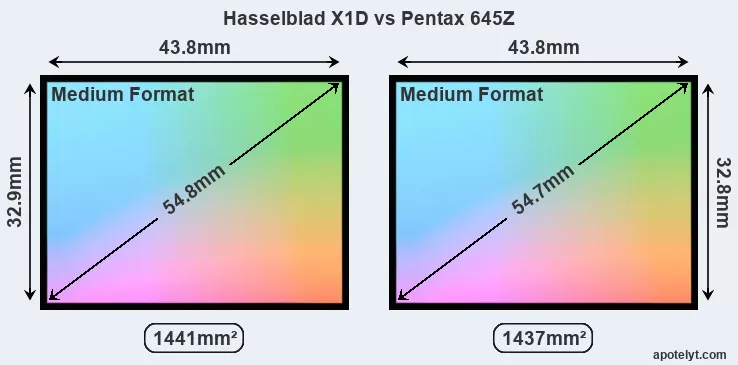
With 51.3MP, the X1D offers a slightly higher resolution than the 645Z (51.1MP), but the X1D nevertheless has the same individual pixel size (pixel pitch of 5.30μm) as the 645Z due to its larger sensor. It is noteworthy in this context that the X1D is a mch more recent model (by 2 years and 2 months) than the 645Z, and its sensor will have benefitted from technological advances during this time that further enhance the light gathering capacity of its pixels. Coming back to sensor resolution, it should be mentioned that neither of the two cameras has an anti-alias filter installed, so they are able to capture all the detail the sensor resolves.
The Hasselblad X1D-50c has a native sensitivity range from ISO 100 to ISO 25600. The corresponding ISO settings for the Pentax 645Z are ISO 100 to ISO 204800 (no boost).
Technology-wise, both cameras are equipped with CMOS (Complementary Metal–Oxide–Semiconductor) sensors. Both cameras use a Bayer filter for capturing RGB colors on a square grid of photosensors. This arrangement is found in most digital cameras.
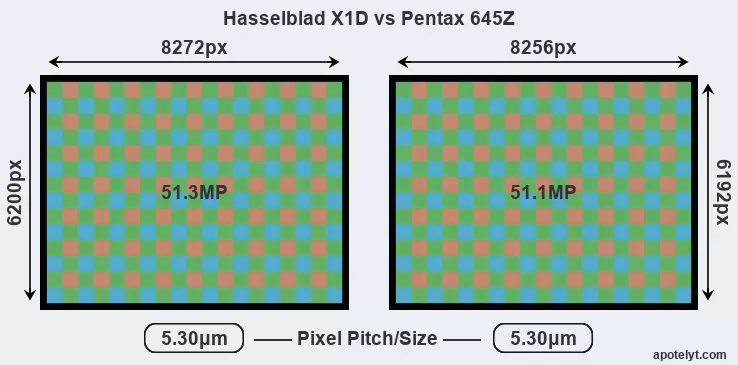
Since 2007, DXO Mark has published sensor performance measurements that have been derived using a consistent methodology. This service determines an overall sensor rating, as well as sub-scores for low-light sensitivity ("DXO Sports"), dynamic range ("DXO Landscape"), and color depth ("DXO Portrait"). The Overall DXO ratings for the two cameras under consideration are close, suggesting that they provide similar imaging performance. The following table provides an overview of the physical sensor characteristics, as well as the sensor quality measurements for a selection of comparators.

| Camera Model |
Sensor Class |
Resolution (MP) |
Horiz. Pixels |
Vert. Pixels |
Video Format |
DXO Portrait |
DXO Landscape |
DXO Sports |
DXO Overall |
||
|---|---|---|---|---|---|---|---|---|---|---|---|
| 1. | Hasselblad X1D | Medium Format | 51.3 | 8272 | 6200 | 1080/25p | 26.2 | 14.8 | 4489 | 102 | |
| 2. | Pentax 645Z | Medium Format | 51.1 | 8256 | 6192 | 1080/60i | 26.0 | 14.7 | 4505 | 101 | |
| 3. | Canon 5DS | Full Frame | 50.3 | 8688 | 5792 | 1080/30p | 24.7 | 12.4 | 2381 | 87 | |
| 4. | Canon 5DS R | Full Frame | 50.3 | 8688 | 5792 | 1080/30p | 24.6 | 12.4 | 2308 | 86 | |
| 5. | Canon 6D Mark II | Full Frame | 26.0 | 6240 | 4160 | 1080/60p | 24.4 | 11.9 | 2862 | 85 | |
| 6. | Fujifilm GFX 50S | Medium Format | 51.1 | 8256 | 6192 | 1080/30p | 25.4 | 14.1 | 2977 | 96 | |
| 7. | Hasselblad X1D II | Medium Format | 51.3 | 8272 | 6200 | 1080/25p | 25.7 | 14.5 | 3234 | 99 | |
| 8. | Leica M11 | Full Frame | 60.3 | 9528 | 6328 | none | 26.3 | 14.8 | 3376 | 100 | |
| 9. | Leica SL | Full Frame | 24.0 | 6000 | 4000 | 4K/30p | 25.0 | 13.4 | 1821 | 88 | |
| 10. | Nikon D7200 | APS-C | 24.0 | 6000 | 4000 | 1080/60p | 24.5 | 14.6 | 1333 | 87 | |
| 11. | Nikon D7500 | APS-C | 20.7 | 5568 | 3712 | 4K/30p | 24.3 | 14.0 | 1483 | 86 | |
| 12. | Pentax 645D | Medium Format | 39.5 | 7264 | 5440 | none | 24.6 | 12.6 | 1262 | 82 | |
| Note: DXO values in italics represent estimates based on sensor size and age. | |||||||||||
Many modern cameras are not only capable of taking still images, but also of capturing video footage. Both cameras under consideration have a sensor with sufficiently fast read-out times for moving pictures, but the 645Z provides a faster frame rate than the X1D. It can shoot movie footage at 1080/60i, while the Hasselblad is limited to 1080/25p.
Feature comparison
Apart from body and sensor, cameras can and do differ across a variety of features. For example, the X1D has an electronic viewfinder (2360k dots), while the 645Z has an optical one. Both systems have their advantages, with the electronic viewfinder making it possible to project supplementary shooting information into the framing view, whereas the optical viewfinder offers lag-free viewing and a very clear framing image. The table below summarizes some of the other core capabilities of the Hasselblad X1D and Pentax 645Z in connection with corresponding information for a sample of similar cameras.

| Camera Model |
Viewfinder (Type or 000 dots) |
Control Panel (yes/no) |
LCD Specifications (inch/000 dots) |
LCD Attach- ment |
Touch Screen (yes/no) |
Max Shutter Speed * |
Max Shutter Flaps * |
Built-in Flash (yes/no) |
Built-in Image Stab |
||
|---|---|---|---|---|---|---|---|---|---|---|---|
| 1. | Hasselblad X1D | 2360 | n | 3.0 / 920 | fixed | Y | 1/2000s | 2.3/s | n | n | |
| 2. | Pentax 645Z | optical | Y | 3.2 / 1037 | tilting | n | 1/4000s | 3.0/s | n | n | |
| 3. | Canon 5DS | optical | Y | 3.2 / 1040 | fixed | n | 1/8000s | 5.0/s | n | n | |
| 4. | Canon 5DS R | optical | Y | 3.2 / 1040 | fixed | n | 1/8000s | 5.0/s | n | n | |
| 5. | Canon 6D Mark II | optical | Y | 3.0 / 1040 | swivel | Y | 1/4000s | 6.5/s | n | n | |
| 6. | Fujifilm GFX 50S | optional | Y | 3.2 / 2360 | full-flex | Y | 1/4000s | 3.0/s | n | n | |
| 7. | Hasselblad X1D II | 3690 | n | 3.6 / 2360 | fixed | Y | 1/2000s | 2.7/s | n | n | |
| 8. | Leica M11 | optical | n | 3.0 / 2333 | fixed | Y | 1/4000s | 4.5/s | n | n | |
| 9. | Leica SL | 4400 | Y | 3.0 / 1040 | fixed | Y | 1/8000s | 11.0/s | n | n | |
| 10. | Nikon D7200 | optical | Y | 3.2 / 1229 | fixed | n | 1/8000s | 6.0/s | Y | n | |
| 11. | Nikon D7500 | optical | Y | 3.2 / 922 | tilting | Y | 1/8000s | 8.0/s | Y | n | |
| 12. | Pentax 645D | optical | Y | 3.0 / 921 | fixed | n | 1/4000s | 1.1/s | n | n | |
| Note: *) Information refers to the mechanical shutter, unless the camera only has an electronic one. | |||||||||||
One differentiating feature between the two cameras concerns the touch sensitivity of the rear screen. The X1D has a touchscreen, while the 645Z has a conventional panel. Touch control can be particularly helpful, for example, for setting the focus point.
The Hasselblad X1D and the Pentax 645Z both have an intervalometer built-in. This enables the photographer to capture time lapse sequences, such as flower blooming, a sunset or moon rise, without purchasing an external camera trigger and related software.
Concerning the storage of imaging data, both the X1D and the 645Z write their files to SDXC cards. Both cameras feature dual card slots, which can be very useful in case a memory card fails. Both cameras can use UHS-I cards, which provide for Ultra High Speed data transfer of up to 104 MB/s.
Connectivity comparison
For some imaging applications, the extent to which a camera can communicate with its environment can be an important aspect in the camera decision process. The table below provides an overview of the connectivity of the Hasselblad X1D-50c and Pentax 645Z and, in particular, the interfaces the cameras (and selected comparators) provide for accessory control and data transfer.

| Camera Model |
Hotshoe Port |
Internal Mic / Speaker |
Microphone Port |
Headphone Port |
HDMI Port |
USB Port |
WiFi Support |
NFC Support |
Bluetooth Support |
||
|---|---|---|---|---|---|---|---|---|---|---|---|
| 1. | Hasselblad X1D | Y | stereo / mono | Y | Y | mini | 3.0 | Y | - | - | |
| 2. | Pentax 645Z | Y | stereo / mono | Y | - | mini | 3.0 | - | - | - | |
| 3. | Canon 5DS | Y | mono / mono | Y | - | mini | 3.0 | - | - | - | |
| 4. | Canon 5DS R | Y | mono / mono | Y | - | mini | 3.0 | - | - | - | |
| 5. | Canon 6D Mark II | Y | stereo / mono | Y | - | mini | 2.0 | Y | Y | Y | |
| 6. | Fujifilm GFX 50S | Y | stereo / mono | Y | Y | micro | 3.0 | Y | - | - | |
| 7. | Hasselblad X1D II | Y | stereo / mono | Y | Y | - | 3.0 | Y | - | - | |
| 8. | Leica M11 | Y | - / - | - | - | - | 3.2 | Y | - | Y | |
| 9. | Leica SL | Y | stereo / mono | Y | Y | full | 3.0 | Y | - | - | |
| 10. | Nikon D7200 | Y | stereo / mono | Y | Y | mini | 2.0 | Y | Y | - | |
| 11. | Nikon D7500 | Y | stereo / mono | Y | Y | mini | 2.0 | Y | - | Y | |
| 12. | Pentax 645D | Y | stereo / - | - | - | - | 2.0 | - | - | - |
It is notable that the X1D has a headphone jack, which is not present on the 645Z This port makes it possible to attach external headphones and monitor the quality of sound during the recording process.
Both cameras feature a PC Sync terminal to control professional strobe lights, which will be appreciated by studio photographers.
Both the X1D and the 645Z have been discontinued, but can regularly be found used on ebay. The X1D was replaced by the Hasselblad X1D II, while the 645Z does not have a direct successor. Further information on the features and operation of the X1D and 645Z can be found, respectively, in the Hasselblad X1D Manual (free pdf) or the online Pentax 645Z Manual.
Review summary
So what conclusions can be drawn? Is the Hasselblad X1D better than the Pentax 645Z or vice versa? A synthesis of the relative strong points of each of the models is listed below.

Reasons to prefer the Hasselblad X1D-50c:
- Better sound control: Has a headphone port that enables audio monitoring while recording.
- More framing info: Has an electronic viewfinder that displays shooting data.
- Fewer buttons to press: Is equipped with a touch-sensitive rear screen to facilitate handling.
- More compact: Is smaller (150x98mm vs 156x117mm) and thus needs less room in the bag.
- Less heavy: Is lighter (by 825g or 53 percent) and hence easier to carry around.
- More legacy lens friendly: Can take a broad range of non-native lenses via adapters.
- Easier file upload: Has wifi built in for automatic backup or image transfer to the web.
- More prestigious: Has the Hasselblad luxury appeal, which ensures a high resale price.
- More modern: Reflects 2 years and 2 months of technical progress since the 645Z launch.

Advantages of the Pentax 645Z:
- Better video: Provides higher movie framerates (1080/60i versus 1080/25p).
- Brighter framing: Features an optical viewfinder for clear, lag-free composition.
- Easier setting verification: Features a control panel on top to check shooting parameters.
- Larger screen: Has a bigger rear LCD (3.2" vs 3.0") for image review and settings control.
- More detailed LCD: Has a higher resolution rear screen (1037k vs 920k dots).
- More flexible LCD: Has a tilting screen for odd-angle shots in landscape orientation.
- Faster shutter: Has higher mechanical shutter speed (1/4000s vs 1/2000s) to freeze action.
- Faster burst: Shoots at higher frequency (3 vs 2.3 flaps/sec) to capture the decisive moment.
- More heavily discounted: Has been around for much longer (launched in April 2014).
If the count of relative strengths (bullet points above) is taken as a measure, the match-up finishes in a tie (9 points each). However, the relevance of individual strengths will vary across photographers, so that you might want to apply your own weighing scheme to the summary points when reflecting and deciding on a new camera. A professional sports photographer will view the differences between cameras in a way that diverges from the perspective of a street photog, and a person interested in family portraits has distinct needs from a landscape shooter. Hence, the decision which camera is best and worth buying is often a very personal one.
How about other alternatives? Do the specifications of the Hasselblad X1D and the Pentax 645Z place the cameras among the top in their class? Find out in the latest Best Mirrorless Interchangeable Lens Camera and Best DSLR Camera listings whether the two cameras rank among the cream of the crop.
In any case, while the specs-based evaluation of cameras can be instructive in revealing their potential as photographic tools, it says little about, for example, the shooting experience and imaging performance of the X1D and the 645Z in practical situations. User reviews, such as those found at amazon, can sometimes inform about these issues, but such feedback is often incomplete, inconsistent, and biased.
Expert reviews
This is why expert reviews are important. The following table reports the overall ratings of the cameras as published by some of the major camera review sites (amateurphotographer [AP], cameralabs [CL], digitalcameraworld [DCW], dpreview [DPR], ephotozine [EPZ], photographyblog [PB]). As can be seen, the professional reviewers agree in many cases on the quality of different cameras, but sometimes their assessments diverge, reinforcing the earlier point that a camera decision is often a very personal choice.

| Camera Model |
AP score |
CL score |
DCW score |
DPR score |
EPZ score |
PB score |
Camera Launch |
Launch Price |
Street Price |
||
|---|---|---|---|---|---|---|---|---|---|---|---|
| 1. | Hasselblad X1D | .. | o | .. | 81/100 | .. | 4/5 | Jun 2016 | US$ 8 995 | ebay.com | |
| 2. | Pentax 645Z | 5/5 | .. | 3.5/5 | .. | 4.5/5 | 5/5 | Apr 2014 | US$ 8 499 | ebay.com | |
| 3. | Canon 5DS | .. | + | .. | 83/100 | 4.5/5 | 4.5/5 | Feb 2015 | US$ 3 699 | ebay.com | |
| 4. | Canon 5DS R | 5/5 | + | .. | 83/100 | 5/5 | 4.5/5 | Feb 2015 | US$ 3 699 | ebay.com | |
| 5. | Canon 6D Mark II | 4/5 | + | 4/5 | 80/100 | 4.5/5 | 4/5 | Jun 2017 | US$ 1 999 | amazon.com | |
| 6. | Fujifilm GFX 50S | .. | .. | 4.5/5 | 85/100 | 5/5 | 4.5/5 | Sep 2016 | US$ 6 499 | ebay.com | |
| 7. | Hasselblad X1D II | .. | .. | 4/5 | .. | 4/5 | 4/5 | Jun 2019 | US$ 5 749 | ebay.com | |
| 8. | Leica M11 | 4.5/5 | .. | 4.5/5 | .. | 4.5/5 | 4.5/5 | Jan 2022 | US$ 8 999 | amazon.com | |
| 9. | Leica SL | 4/5 | .. | 4/5 | 84/100 | 4.5/5 | 4/5 | Oct 2015 | US$ 7 449 | ebay.com | |
| 10. | Nikon D7200 | 4/5 | + + | .. | 84/100 | 4.5/5 | 4.5/5 | Mar 2015 | US$ 1 199 | ebay.com | |
| 11. | Nikon D7500 | 4.5/5 | + + | 4.5/5 | 86/100 | 5/5 | 4.5/5 | Apr 2017 | US$ 1 299 | amazon.com | |
| 12. | Pentax 645D | 5/5 | .. | .. | .. | .. | .. | Mar 2010 | US$ 9 995 | ebay.com | |
| Note: (+ +) highly recommended; (+) recommended; (o) reviewed; (..) not available. | |||||||||||
Care should be taken when interpreting the review scores above, though. The assessments were made in relation to similar cameras of the same technological generation. A score, therefore, has to be seen in close connection to the price and market introduction time of the camera, and rating-comparisons among cameras that span long time periods or concern very differently equipped models make little sense. Also, please note that some of the review sites have changed their methodology and reporting over time.

Check X1D offers at
ebay.com

Check 645Z offers at
ebay.com
Other camera comparisons
Did this review help to inform your camera decision process? In case you are interested in seeing how other cameras pair up, just make a corresponding selection in the search boxes below. There is also a set of direct links to comparison reviews that other users of the CAM-parator app explored.
- Canon 70D vs Pentax 645Z
- Canon G7 X Mark III vs Hasselblad X1D
- Canon M10 vs Hasselblad X1D
- Canon SL2 vs Pentax 645Z
- Fujifilm X-Pro2 vs Hasselblad X1D
- Hasselblad X1D vs Pentax K-70
- Hasselblad X1D vs Sony A850
- Hasselblad X1D vs Sony NEX-3
- Nikon D2Xs vs Pentax 645Z
- Nikon D3500 vs Pentax 645Z
- Panasonic ZS70 vs Pentax 645Z
- Pentax 645Z vs Sony RX10 IV
Specifications: Hasselblad X1D vs Pentax 645Z
Below is a side-by-side comparison of the specs of the two cameras to facilitate a quick review of their differences and common features.
| Camera Model | Hasselblad X1D | Pentax 645Z |
|---|---|---|
| Camera Type | Mirrorless system camera | Digital single lens reflex |
| Camera Lens | Hasselblad X mount lenses | Pentax 645 mount lenses |
| Launch Date | June 2016 | April 2014 |
| Launch Price | USD 8,995 | USD 8,499 |
| Sensor Specs | Hasselblad X1D | Pentax 645Z |
| Sensor Technology | CMOS | CMOS |
| Sensor Format | Medium Format Sensor | Medium Format Sensor |
| Sensor Size | 43.8 x 32.9 mm | 43.8 x 32.8 mm |
| Sensor Area | 1441.02 mm2 | 1436.64 mm2 |
| Sensor Diagonal | 54.8 mm | 54.7 mm |
| Crop Factor | 0.79x | 0.79x |
| Sensor Resolution | 51.3 Megapixels | 51.1 Megapixels |
| Image Resolution | 8272 x 6200 pixels | 8256 x 6192 pixels |
| Pixel Pitch | 5.30 μm | 5.30 μm |
| Pixel Density | 3.56 MP/cm2 | 3.56 MP/cm2 |
| Moiré control | no AA filter | no AA filter |
| Movie Capability | 1080/25p Video | 1080/60i Video |
| ISO Setting | 100 - 25,600 ISO | 100 - 204,800 ISO |
| DXO Sensor Quality (score) | 102 | 101 |
| DXO Color Depth (bits) | 26.2 | 26.0 |
| DXO Dynamic Range (EV) | 14.8 | 14.7 |
| DXO Low Light (ISO) | 4489 | 4505 |
| Screen Specs | Hasselblad X1D | Pentax 645Z |
| Viewfinder Type | Electronic viewfinder | Optical viewfinder |
| Viewfinder Field of View | 100% | 98% |
| Viewfinder Magnification | 0.78x | |
| Viewfinder Resolution | 2360k dots | |
| Top-Level Screen | no Top Display | Control Panel |
| LCD Framing | Live View | Live View |
| Rear LCD Size | 3.0inch | 3.2inch |
| LCD Resolution | 920k dots | 1037k dots |
| LCD Attachment | Fixed screen | Tilting screen |
| Touch Input | Touchscreen | no Touchscreen |
| Shooting Specs | Hasselblad X1D | Pentax 645Z |
| Focus System | Contrast-detect AF | Phase-detect AF |
| Manual Focusing Aid | Focus Peaking | Focus Peaking |
| Max Shutter Speed (mechanical) | 1/2000s | 1/4000s |
| Continuous Shooting | 2.3 shutter flaps/s | 3 shutter flaps/s |
| Time-Lapse Photography | Intervalometer built-in | Intervalometer built-in |
| Fill Flash | no On-Board Flash | no On-Board Flash |
| Storage Medium | SDXC cards | SDXC cards |
| Single or Dual Card Slots | Dual card slots | Dual card slots |
| UHS card support | UHS-I | UHS-I |
| Connectivity Specs | Hasselblad X1D | Pentax 645Z |
| External Flash | Hotshoe | Hotshoe |
| Studio Flash | PC Sync socket | PC Sync socket |
| USB Connector | USB 3.0 | USB 3.0 |
| HDMI Port | mini HDMI | mini HDMI |
| Microphone Port | External MIC port | External MIC port |
| Headphone Socket | Headphone port | no Headphone port |
| Wifi Support | Wifi built-in | no Wifi |
| Body Specs | Hasselblad X1D | Pentax 645Z |
| Environmental Sealing | Weathersealed body | Weathersealed body |
| Battery Type | Hasselblad H-3054752 | Pentax D-LI90 |
| Body Dimensions |
150 x 98 x 71 mm (5.9 x 3.9 x 2.8 in) |
156 x 117 x 123 mm (6.1 x 4.6 x 4.8 in) |
| Camera Weight | 725 g (25.6 oz) | 1550 g (54.7 oz) |

Check X1D offers at
ebay.com

Check 645Z offers at
ebay.com
Did you notice an error on this page? If so, please get in touch, so that we can correct the information.

